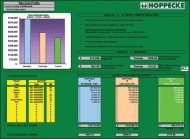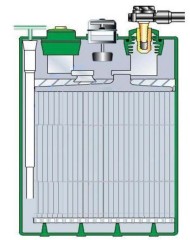 A campaign by leading battery supplier HOPPECKE UK has highlighted the need for a total rethink about how industry manages its battery supply and charging operations. With a powerful and thought provoking advertisement hitting the trade press, HOPPECKE’s aim is to re-educate industry, change the perception of battery supply and underline the cost effective management of DC energy systems.
A campaign by leading battery supplier HOPPECKE UK has highlighted the need for a total rethink about how industry manages its battery supply and charging operations. With a powerful and thought provoking advertisement hitting the trade press, HOPPECKE’s aim is to re-educate industry, change the perception of battery supply and underline the cost effective management of DC energy systems.
By taking this approach, HOPPECKE UK has made sure that it’s not only monetary costs that are on the agenda. Environmental issues are also at the core of the company’s blueprint for change, by providing a sustainable solution for the reduction of industry’s carbon footprint. HOPPECKE’s trak® air system has been designed with such issues in mind. As Bernard Molloy, Managing Director of HOPPECKE UK explained: “We needed to look at the whole concept of batteries as an energy supplier. Not only at the rate of energy consumption, but also reducing downtime and of course increasing fleet availability. The natural progression from this was to look at the positive effects that our systems could have on the environment.”
The principle of HOPPECKE’s trak® air is relatively simple. When a battery is charged, concentrated sulphuric acid is formed. Sulphuric acid is heavy and naturally sinks towards the bottom of the cell, resulting in acid stratification.
In standard systems, the removal of this stratification is achieved when the electrolyte is mixed through rising gas bubbles. The gaseous bubbles are produced by defined overcharging of the electrodes. The deliberate overcharging, means an increase energy and water consumption, extended charging times and higher temperatures.
The HOPPECKE trak® air system avoids these consequences. Air is introduced into the battery right at the main charging stage. The rising air bubbles circulate around the electrolyte and prevent the stratification of acid. In comparison with other methods, mixing sulphuric acid by in-blown air creates maximum efficiency, places minimal stress on the plate group and eliminates the need for the otherwise necessary weekly equalising charges. The charging system also plays an important part within the new battery system. The HOPPECKE trak® air charger houses a state of the art micro-processor which acts as a data management system and reduces charging time by up to two and a half hours.
The cost effectiveness of HOPPECKE’s trak® air systems are verified by an independent body to be 100 per cent accurate. Savings of up to 43 per cent can be achieved when using the system. Working with its customers HOPPECKE has found that a basic 50Hz charger, operated over a five year period would accumulate a running cost £742,710. With the new system in place, the costs are significantly reduced to £430,173, saving a total of £312,538. The substantial savings that are made in CO2 emissions are just as phenomenal. Over the same five year period, the trak® air system will save 1259.50 tonnes of CO2. This is achieved through the efficiency of the charger and the operational savings associated with the system.
 “It’s more than just creating a new product for the market,” said Bernard. “It’s creating a whole new ethos. With HOPPECKE’s trak® air principle, we have developed a system which is not only cost effective but also environmentally friendly. This is an important step forward in the industry and one which we are proud to be taking the lead.”
“It’s more than just creating a new product for the market,” said Bernard. “It’s creating a whole new ethos. With HOPPECKE’s trak® air principle, we have developed a system which is not only cost effective but also environmentally friendly. This is an important step forward in the industry and one which we are proud to be taking the lead.”
Hoppecke Industrial Batteries Ltd Bernard Molloy Tel: 01782 667305 Email: bernardmolloy@hoppecke.co.uk www.hoppecke.co.uk




Comments are closed.